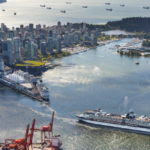Canada’s maritime centre Vancouver, in British Columbia, already home to a large shipping cluster, continues to grow and has redoubled its efforts to attract new industry participants. For HANSA, Barry Parker took a closer view
In the past year, the Vancouver International Maritime Center (VIMC), supported by a group of top executives, in conjunction with[ds_preview] Canadian and Provincial governments, is one year into an aggressive campaign to encourage shipping businesses to locate in Vancouver – without vessel ownership or flagging requirements. The »software« side of the business, tax, financial and commercial advantages for companies operating in Canada, are what is stressed by VIMC. In explaining the organizational advantages of Canada, financial advisor Michael Shields, Partner in the Vancouver office of PricewaterhouseCoopers, which works closely with VIMC, contrasted Canada with better known shipping tax havens, saying that: »The administrative costs of running an entire corporate group is significantly reduced because of our rules.« Katy Arsoniadis-Stein, VIMC’s Executive Director, said that multipurpose operator AAL Shipping was the first company to come in as a result of its efforts, which included presentations in shipping hubs around the world as the first step in wooing shipping offices. Another new arrival is the recently formed Greystoke Marine Management Ltd., an advisor to financial investors.
The 2015 statistics showed 3,128 international vessel calls – with flows of 96.2mill. t of bulk cargo, 16.5mill. t of breakbulk cargo (mainly forest products and steel), 3.1mill. TEU (closely balanced between import and export), and nearly 400,000 autos (mainly from Asia).
Vancouver is looking very much about the future; in 2010, the port embarked on its forward-looking »Port 2050« planning exercise a in close consultation with external stakeholders. This plan was subsequently updated in late 2015. Katherine Bamford, the port’s Director ofTrade Development, explained that the port is one of 19 ports mandated by Canada’s Marine Act of 1998, and, as such, takes a broad international view. The future means growth; plans to expand an existing container terminal at Roberts Bank call for an additional 2.4mill.TEU annual capability. If the three-berth project goes ahead, construction would begin in 2018 and would be operational by the mid-2020s, when economic forecasts indicate that the capacity will be required.
The port, required under its Federal mandate to be financially self-sufficient, is well run. Ms. Bamford explained that the port is »… set up like a hub, much like an airport …« with all of the marine, rail and truck activity managed through a 24 hour operations center. Indicative of this operational excellence and ability to utilize Big Data is the requirement that all container trucks serving the port be equipped with GPS units – which enables »turn times«, an important Key Performance Indicator (KPI) to be charted to the minute.
Vancouver is a landlord port, where the individual terminals rent their space and conduct operations and revenues from its four container terminals account for 45% of the port’s revenues. The »Port 2050« plan provides guideposts as Vancouver moves forward; the 2015 revision, prepared by the Deloitte consultancy develops four cases for the future
The »scenarios« consider possible changes in global geopolitics, production and consumption of goods and resources, the transitions underway in the energy business, and technological changes.
Sustainability is integral to the fabric of Vancouver’s port operations now (with its cruise terminals providing »shore power« since 2009), and in the future. The port’s groundbreaking Eco-Action plan uses monetary incentives, in the form of reduced harbor dues, to reward vessels burning clean fuels and achieving reduced emissions.
The scenario planning identifying three cornerstones for Vancouver – economic prosperity through trade, a healthy environment and thriving communities. Vancouver is well positioned for all three.
The most favorable outcome identified by Ms. Bamford is called »The Great Transition«, which is a scenario »where we see a paradigm shift — a rapid transition to a post-industrial/post-carbon model.« The backdrop, to be closely monitored by planners at the port (through periodic revisions to Port 2050), is a situation where trade growth continues, buttressed by the requisite investments in infrastructure to support it.
The Vancouver shipping community includes many well known outfits. Twenty five years after its move north from Long Beach, the Teekay organization chart shows the corporate parent and four other entities. In the clean products and chemicals sector of the tanker trades, Waterfront Shipping (wholly owned by the listed company Methanex) operates a fleet of two dozen ships, mainly in the MR sizes. Six vessels, newly delivered from Japanese and Korean yards during 2016, are capable of running on methanol. Oldendorf Carriers and Pacific Basin, two drybulk mainstays, both have Vancouver offices – part of worldwide networks.
Another Vancouver stalwart, and a driving force within VIMC, are the two Seaspan companies. Seaspan Corporation is a listed containership ownerand manager, with a fleet of more than 100 owned and managed vessels on charter to well known liner carriers. Seaspan ULC is the privately owned parent of a newbuild yard – Vancouver Shipyard, a drydock and repair facility , a towing / ship assist capability (docking roughly 70% of all the vessels around the Vancouver gateway), a bunker company (also with a 70% local share) and the owner and operator of a cargo ferry service. Seaspan ULC Chairman Mr. Jonathan Whitworth, in a press briefing attended by HANSA, highlighted Seaspan Ferries construction program for two new Vard-designed ferries at the Sedef Shipyard, in Turkey. Mr. Whitworth said »… this will be the first hybrid ship in North America … running primarily on LNG but with ability to run on marine diesel or batteries as backup.« In late October the first vessel, to be christened as »Seaspan Swift«, was delivered.
Vancouver Shipyard, the newbuild facility in North Vancouver, bid and won an award under the 2011 National Shipbuilding Programming Strategy (NSPS) to construct seven »non-combatant« vessels for the Canadian government, with up to ten additional awards possible. Following an extensive $170 million modernization at the Vancouver Shipyard, construction of the first vessel, »Sir John Franklin«, a Offshore Fisheries Science Vessel (OFSV), being built for Canada’s Coast Guard, is 50% complete. A second vessel is also under construction. Mr. Whitworth, who logged time at Teekay, earlier in his career, described the NSPS as »… giving a shot in the arm for shipbuilding in Canada …«. For Seaspan ULC, the government program was a true game changer, with Mr. Whitworth saying: »We were on the verge of closing down one, maybe two of our yards … October 19, 2011, the day that the positive result of the bidding was announced, was the day that everything changed.«
Barry Parker




















